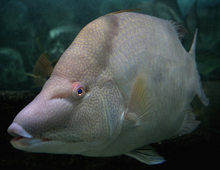Description: The Rooster hogfish has a large high round, compressed body with a long snout and protractile mouth (can extend and withdraw mouth). Males are a gray brown overall and a dark color from the snout to the forehead. The iris is bright red, the pectoral fins are yellow with darker bars on the outer margins of the dorsal, anal and caudal fins. Females are a pale gray, brown or reddish- brown with a pale underside.
Size: They can reach lengths of three feet (0.91 m) and weigh 22 pounds (10 kg).
Behavior: They root around in sediment in search for crustaceans by using their long “ pig-like “ snout, thus the common name hogfish. They are protogynous hermaphrodites – all are born female and later change to male. Harems are formed with larger male dominating groups of females
Diet: Their powerful jaws and teeth equip them to consume crabs, sea urchins and mollusks.
Senses: Eyesight is keen. They have an excellent sense of smell that is used to root out food.
Communication: Changing color is their way of communicating in their environment.
Reproduction: The male and female release gametes at the same time into the water where external fertilization takes place. After fertilization, the eggs quickly develop in the larvae stage for a short period of time until they grow into juveniles.
Habitat/range: They are found over open bottoms and coral reefs at depths ranging from 10-100 feet (3-30 m) in the western Atlantic Ocean, the northern Gulf of Mexico and south through the Caribbean Sea.
Status: Listed as Vulnerable on the IUCN Red List due to overfishing.



